The Genus Baptisia in South Carolina
by Bill Stringer*
Reprinted from the Winter 2012 Journal of the South Carolina Native Plant Society, and used by permission.
To see additional pictures or information about a particular plant, click its name.
In my humble opinion, some of the most spectacular herbaceous perennials in our State are in the genus Baptisia. These beautiful native legumes share the generic common name of wild indigo, a name derived from their use as dyestuff plants by the Native Americans and early Europeans. In fact, Baptisia is from the Latin baptisis, or a dipping, relating to the dyeing procedure. The native American plant, Baptisia tinctoria, was cultivated in colonial times for a pale blue dye, but was a poor substitute for introduced Indigo (Indigofera tinctoria).
Baptisia species exhibit a peculiar trait of early canopy senescense. The canopy leaves and stems die and turn dark in late summer or early fall, considerably earlier than the first frost. The early change in color results from enzymatic reactions in the plant that create the blue pigment. This is most likely a day-length response. The senesced stems can break off at the soil level, thus creating a “tumbleweed”, which no doubt aids in dispersing seeds. A crown atop the sturdy taproot produces large sub-surface buds that give rise to next year’s plant canopy.
Members of the genus Baptisia are all nitrogen-fixing legumes, and as such, play an important role in providing fixed nitrogen for natural plant communities. They are all long-lived perennials with sturdy branched taproot systems. Baptisias are found on mesic to dry soil sites, and in open to partially forested sites where they get partial to full sun. Thus you can commonly spot Baptisias along road and utility rights-of-way, or in prairie-like, or glady sites.
Baptisia species are not seriously affected by pests. The most obvious insect activity on Baptisia comes from seed weevils. One such weevil is Apion rostrum, the adult of which lays her eggs in the young green pods, where the emerging larvae eat some of the forming seeds. Young adult weevils are commonly found when mature pods are opened to harvest the seeds. Scientists estimate that up to 25 percent of the seed production is lost to weevils. In addition, larvae of Wild Indigo Duskywing, Hoary Edge, Southern Dogface, and Orange Sulfur butterflies, and Black-Spotted Prominent moth can be found on Baptisia species, but larval herbivory never appears to be substantial, probably because Baptisias contain alkaloids called quinolizidines that are toxic to herbivores.
The Baptisias make wonderful contributions to our natural and planted landscapes. They produce copious flowers in a variety of colors. Plants can persist for many years in sunny to partially shaded sites. They have deep roots that allow them to survive droughty growing seasons, and can persist on poor acid soils, where they produce their own nitrogen fertilizer. Watch for them on you local naturalized roadsides next summer!
There are eight species of Baptisia found in South Carolina.
Spiked wild indigo — Baptisia albescens

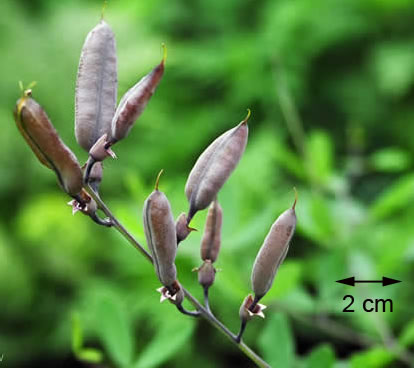
Photos courtesy of www.namethatplant.net
This is probably the most common Baptisia in South Carolina, found in almost every county. Plants are commonly tall (ranging from two to four feet) and cylindrical in shape. The leaves are commonly bluish-green, and die to a blue-black color in early fall. The flowers are white to ivory in color, densely borne on terminal blue to purple-stemmed, glaucous racemes. The fruit is a pod (legume) commonly about the diameter of a wooden pencil by 1.5 inches long, and yellowish-brown at maturity.
White wild indigo — Baptisia alba
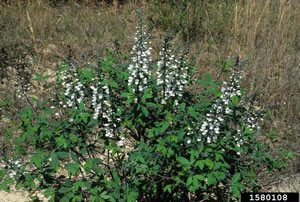
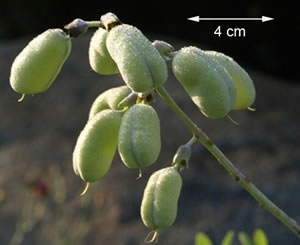
Left photo courtesy of John Ruter, University of Georgia, www.bugwood.org
Right photo courtesy of www.robsplants.com
This species is very similar to B. albescens, in plant size and shape, flower size and color. It is easiest to differentiate from B. albescens in fruit, with the pods being much larger in diameter. Also, the leaves are often considerably larger. The leaves die to a blue-black color in early fall. This species is found all over SC, in similar habitats as B. albescens, but is most common in the lower Piedmont and upper Coastal Plain counties.
Blue wild indigo — Baptisia australis


Left photo courtesy of Dr. Paul Cappiello, Yew Dell Gardens
Right photo courtesy of Lisa J. Miner, www.plantilus.com
This species grows from two to four feet tall. It has large blue-green leaves, much larger than B. alba or albescens. It is spectacular in bloom, exhibiting large pale blue to deep blue flowers in dense racemes. The pods are large and inflated, the diameter commonly as great as one-half the pod length. The leaves die to a blue-black color in early fall. This species has been widely planted, but is thought to have only a small area of natural occurrence in SC, in some of the Sandhills counties.
Long-bract wild indigo, a.k.a. Creamy wild indigo — Baptisia bracteata
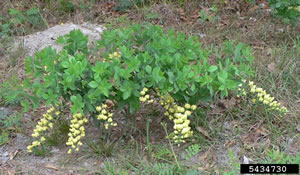
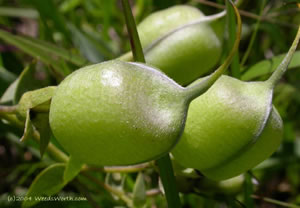
Left photo courtesy of Larry Trekell, www.bugwood.org
Right photo courtesy of www.weedsworth.com
This Baptisia is lower growing that most of the other species. It forms dense rounded clumps (18 inches or so tall), with yellow-green leaves and cream-yellow blooms in downward-pointing racemes. The pods are inflated (3/4 inch in diameter) and quickly turn a dark blue-black (early August). By early September, the canopy has died and turned dark gray along roadsides in the mid- to lower Piedmont and Sandhills. The entire top of the plant dies, right back to the ground.
Gray-hairy wild indigo — Baptisia cinerea
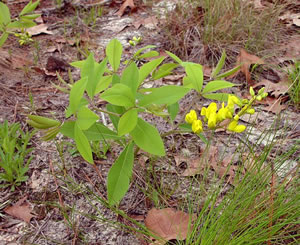
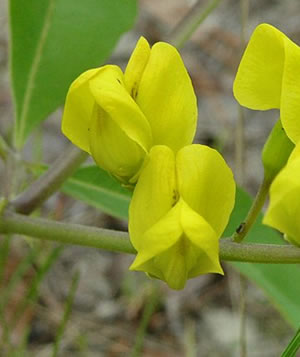
Photos courtesy of Dan Tenaglia, www.alabamaplants.com
This species grows upright to 2-2.5 feet tall, with deep yellow flowers in terminal racemes. The stems are covered with short prostrate gray hairs. It is unique in having long narrow stipules that adhere to the plant. The pod is inflated, thick-walled and strong at maturity. The species is most commonly found in the Sandhills and in thin-forested sites in sandy soils.
Gopherweed — Baptisia lanceolata
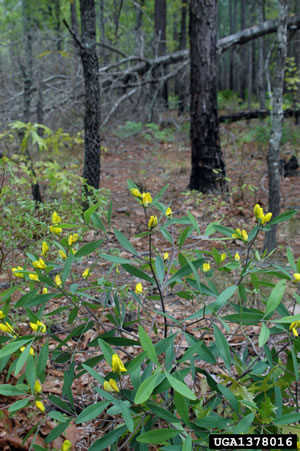
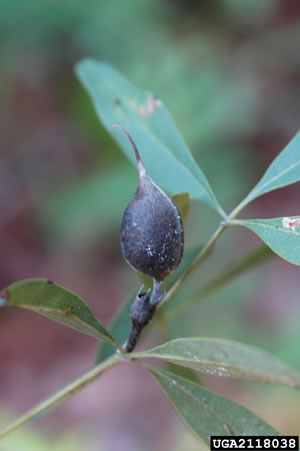
Photos courtesy of Chris Evans, River to River CWMA, www.bugwood.org
A good distinguishing characteristic of gopherweed is the distinctly lanceolate leaflets on its trifoliate leaves, which are 5X as long as they are wide. The leaves are short-pubescent, particularly on the undersides. The flowers are a bright yellow and borne 2 to 4 on short flowering branches. The fruit is a globose pod (3/4 inch) with a sizeable beaked point. Gopherweed is found on dry sandy soils in the Sandhills and upper Coastal Plain. It is similar in appearance to B. cinerea.
Catbells — Baptisia perfoliata
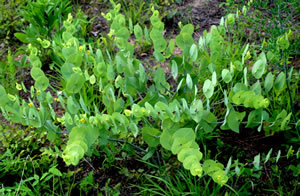
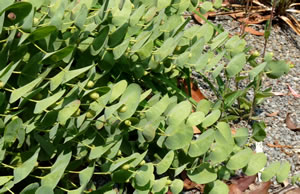
Photos courtesy of the author
This species is easily distinguished from every other species in the genus. It has unifoliate leaves, which are sessile and perfoliate to the stem, looking ever so much like a small eucalyptus. The bright yellow flowers are borne singly in the axil between the leaf and the stem. Sturdy round pods (up to one-half inch in diameter) are formed, and contain as many as four seeds per pod. The common name is derived from the appearance of the seed pods. Catbells is found only in the lower fringe of the Piedmont and the Sandhills.
Horsefly weed — Baptisia tinctoria
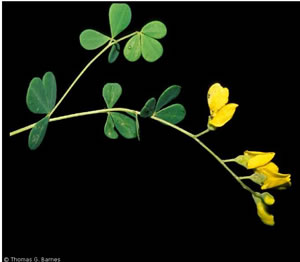
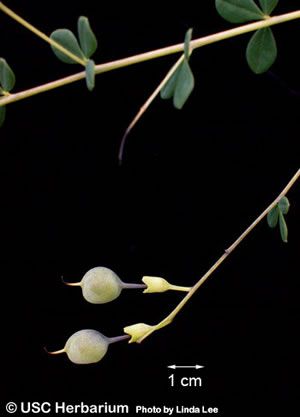
Left photo courtesy of Tom Barnes, http://plants.usda.gov
Right photo courtesy of SC Plant Atlas, http://herbarium.biol.sc.edu/scplantatlas.html
This is the small Baptisia. The plant can be 2-3 feet tall, but has small leaves, small yellow flowers and small fruits. The leaves are trifoliate, with leaflets up to 3/4 inch long. The flowers are 1/2 inch long, bright yellow and occur singly. The pods are up to about 3/8 inch long, 1/4 inch in diameter and usually contain 1 to 4 seeds. Legend has it that a B. tinctoria plant attached to your horse’s collar would ward off horseflies from the horse and the buggy passengers. A wonderful thing if you were squiring your best girl on a Sunday afternoon! Also, it was the Baptisia most commonly used to produce a blue dye. It is found throughout the State.
Vegetative Characters of Baptisia Species
| Species | Leaflets | Leaf Connection | Leaflet Shape* | Leaflet Length | Stipules | Pubescence? | Flower Color | Raceme Location | Flowers/ Raceme | Legume Characteristics |
|---|---|---|---|---|---|---|---|---|---|---|
| B. alba | 3 | petiolate | elliptic | 4 cm | small, late deciduous |
glabrous | white | stem tips | many | thin-walled, inflated (to 25mm diameter), oval |
| B. albescens | 3 | petiolate | elliptic | 4 cm | small, deciduous |
glabrous | white | stem tips | many | thin-walled, narrow (to 9mm diameter), long |
| B. australis | 3 | petiolate | obovate | 6 cm | persistent | glabrous | blue | stem tips | many | thin-walled, 25mm diameter, oval |
| B. bracteata | 3 | petiolate | elliptic | 4 cm | large, persistent |
pubescent | cream | descending branches | many | inflated (to 25mm diameter), oval |
| B. cinerea | 3 | petiolate | elliptic | 6 cm | persistent | pubescent | yellow | lateral | many | hard-walled, inflated, oval |
| B. lanceolata | 3 | petiolate | lanceolate | to 8 cm | tiny, deciduous |
pubescent | yellow | all over | 2-4 | thin-walled, inflated, ovate/ spiked |
| B. perfoliata | 1 | perfoliate | round | 4 cm | none | glabrous | yellow | no racemes | 1 per leaf axil | hard-walled, spherical (to 15mm diameter) |
| B. tinctoria | 3 | petiolate | ovate | 1 cm | tiny, deciduous |
glabrous | yellow | many on branches | few | thin-walled, spherical (to 10mm diameter) |
* Dr. Stringer is an Associate Professor Emeritus of Agronomy in the Department of Entomology, Soils and Plant Sciences, Clemson University, former State President and current Upstate Chapter President of the South Carolina Native Plant Society.

